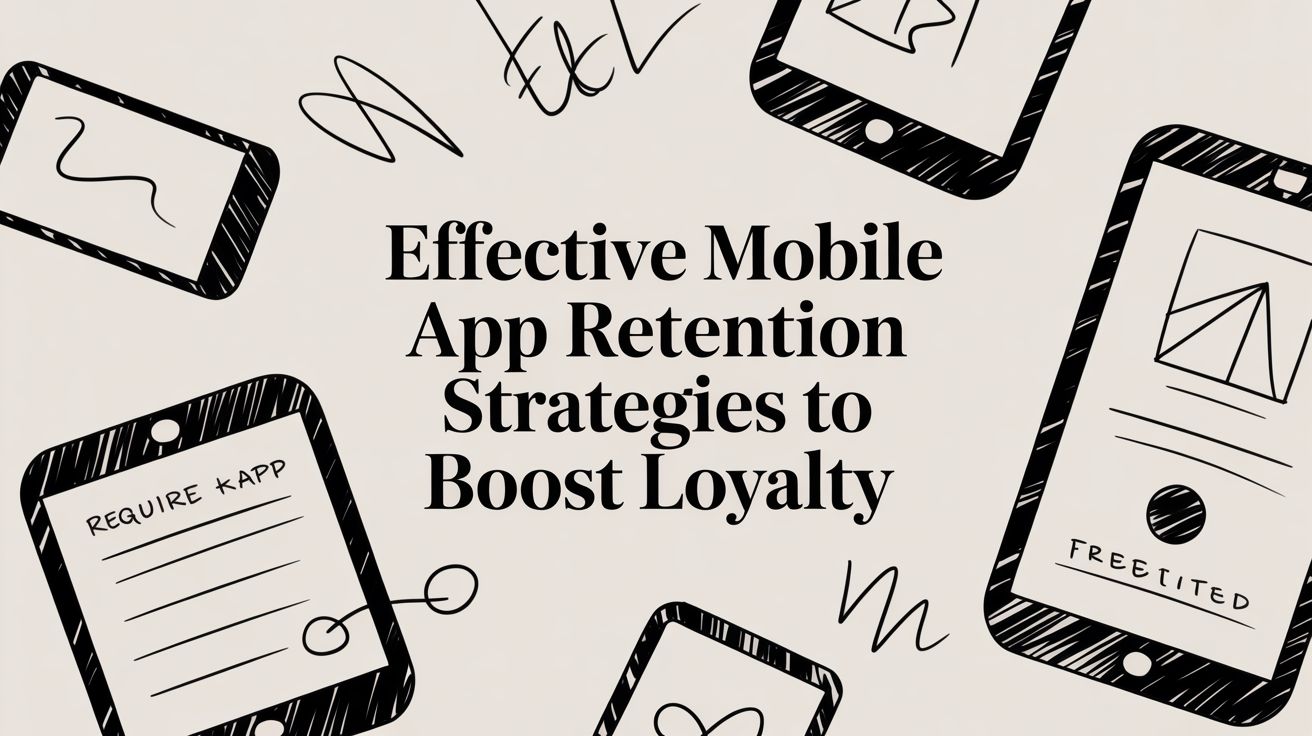
Effective Mobile App Retention Strategies to Boost Loyalty
Explore top mobile app retention strategies to reduce churn. Learn how personalized onboarding, gamification, and notifications enhance user engagement.
Acquiring new users is only half the battle; the real challenge is keeping them. With the average app losing over 75% of its users within the first three days, a robust retention plan isn't just a nice-to-have, it's essential for survival and long-term growth. The difference between a fleeting success and a category leader often comes down to a deliberate, data-driven approach to user engagement and value delivery. Many product teams focus heavily on the initial download, only to see their hard-won users disappear within weeks, driving up customer acquisition costs and stalling revenue growth. This cycle of churn is not inevitable, but breaking it requires a strategic shift from acquisition-at-all-costs to sustainable, long-term user satisfaction.
This article moves beyond generic advice to provide a roundup of ten powerful, actionable mobile app retention strategies that you can implement today. We will break down each strategy with practical steps, real-world examples from industry leaders, and the key metrics to track your success. You will learn how to transform your user experience from a one-time transaction into an ongoing relationship. From personalized onboarding that demonstrates immediate value to sophisticated re-engagement campaigns that bring users back, these techniques are designed for immediate impact.
Whether you're an indie developer, a mobile product manager, or part of a growth team, this comprehensive guide will equip you with the tools to build a loyal, active user base that stands the test of time. We will cover specific tactics for:
- Personalized Onboarding to make a strong first impression.
- Push Notification Optimization that engages without annoying.
- Gamification and Reward Systems to foster habit-forming behavior.
- In-App Messaging to provide proactive support and guidance.
- Performance Optimization to ensure a flawless technical experience.
By implementing these proven mobile app retention strategies, you can significantly reduce churn, increase lifetime value, and build a thriving app ecosystem.
1. Personalized Onboarding
The first few moments a user spends in your app are critical. A personalized onboarding experience tailors this initial interaction to individual user needs, goals, and preferences. Instead of a generic tour, this strategy creates a custom path that highlights relevant features, demonstrates immediate value, and helps users achieve their "aha moment" much faster. This is one of the most effective mobile app retention strategies because it proves from the very first launch that your app understands and can solve the user's specific problem.
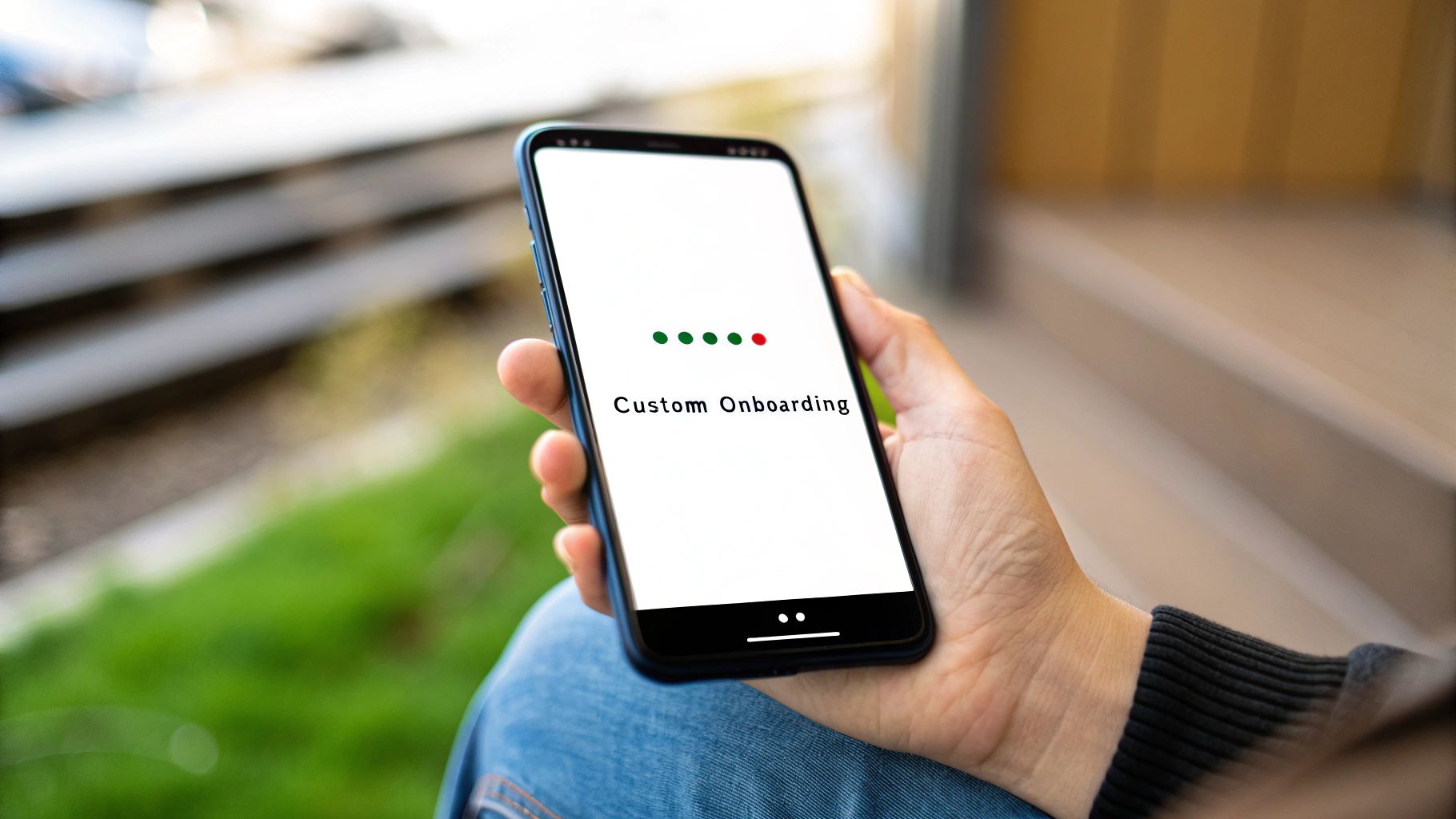
This approach significantly reduces churn by eliminating friction and confusion. When users see content and features that align with their stated goals, they are far more likely to invest time in learning the app and integrate it into their daily routine.
How to Implement Personalized Onboarding
Effective personalization starts with gathering just enough information to customize the experience without overwhelming the user. For instance, Duolingo asks users which language they want to learn, their motivation (e.g., travel, career), and their current skill level. This data immediately shapes a unique learning path, making the user feel the app is built just for them. Similarly, Spotify asks new users to select a few favorite artists, instantly populating their home screen with relevant playlists and recommendations.
Here are actionable tips to implement this strategy:
- Ask Goal-Oriented Questions: In a few simple steps (3-5 screens maximum), ask users what they want to achieve. A fitness app might ask about weight loss vs. muscle gain goals.
- Segment Users Early: Use the initial answers to tag users into segments. This allows for targeted messaging, feature highlights, and push notifications later on.
- Show, Don't Just Tell: Use interactive elements or tooltips within the actual app interface rather than static tutorial screens. This contextual guidance is more engaging and effective.
- Provide a Skip Option: Always allow users to skip the onboarding process. Power users or those reinstalling the app will appreciate the ability to jump right in.
By personalizing the first run experience, you shift from a generic welcome to a guided, value-driven introduction. This builds a strong foundation for long-term engagement and is a cornerstone of successful mobile app retention.
2. Push Notification Optimization
Strategic push notifications are a powerful direct line to your users, but they must be handled with care. Push notification optimization moves beyond generic broadcasts to deliver timely, relevant, and personalized messages that provide genuine value. Instead of being intrusive, a well-crafted notification can re-engage a user at the perfect moment, remind them of the app's value, and bring them back to complete an action. This is a critical component of modern mobile app retention strategies because it keeps your app top-of-mind without causing notification fatigue.
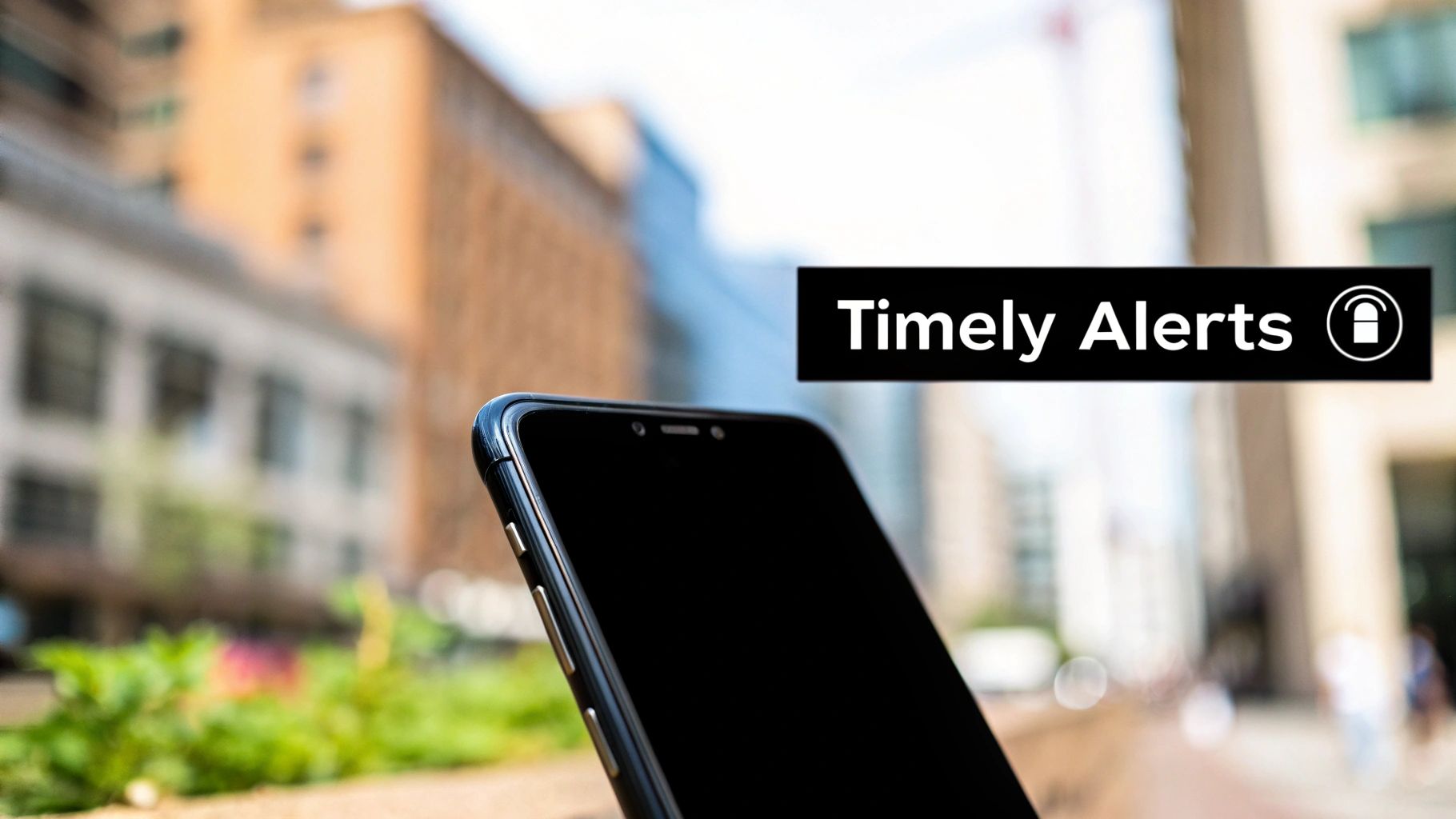
This approach dramatically improves user re-engagement by transforming a potential annoyance into a welcome interaction. When a notification feels helpful, like a reminder for a task or a highly relevant content update, users are more likely to return to the app and less likely to disable notifications or uninstall it altogether.
How to Implement Push Notification Optimization
Successful optimization hinges on understanding user context and behavior. For example, Duolingo sends streak reminders that tap into gamification and loss aversion, motivating users to maintain their daily practice. Similarly, Uber Eats leverages time-based triggers to suggest lunch or dinner, catching users at moments of high intent. These notifications succeed because they are contextually relevant and directly beneficial to the user.
Here are actionable tips to implement this strategy:
- Ask at the Right Time: Don't request notification permission on the first launch. Instead, ask after a user has experienced a positive outcome, like completing their first task or reaching a milestone.
- Segment Your Audience: Group users based on behavior, preferences, and engagement levels. A disengaged user might need a different message than a power user.
- Personalize the Content: Go beyond using just the user's name. Reference their recent activity, location, or stated preferences to make the message feel unique.
- Provide Clear Value: Every notification should answer the user's question: "What's in it for me?" Offer a discount, a helpful tip, or a relevant content update.
- Test and Monitor: A/B test message copy, send times, and the use of emojis. Closely monitor opt-out rates to identify what isn't working and adjust your strategy accordingly.
By optimizing your push notifications, you create a valuable communication channel that strengthens user relationships and drives consistent, long-term engagement.
3. Gamification and Reward Systems
Gamification integrates game-like mechanics such as points, badges, leaderboards, and challenges into non-game apps. This strategy leverages innate human desires for achievement, competition, progress, and reward to make user interactions more engaging and habit-forming. By turning routine tasks into rewarding experiences, you create an emotional investment that keeps users coming back. This is a powerful component of any mobile app retention strategies because it transforms app usage from a functional task into an intrinsically motivating activity.
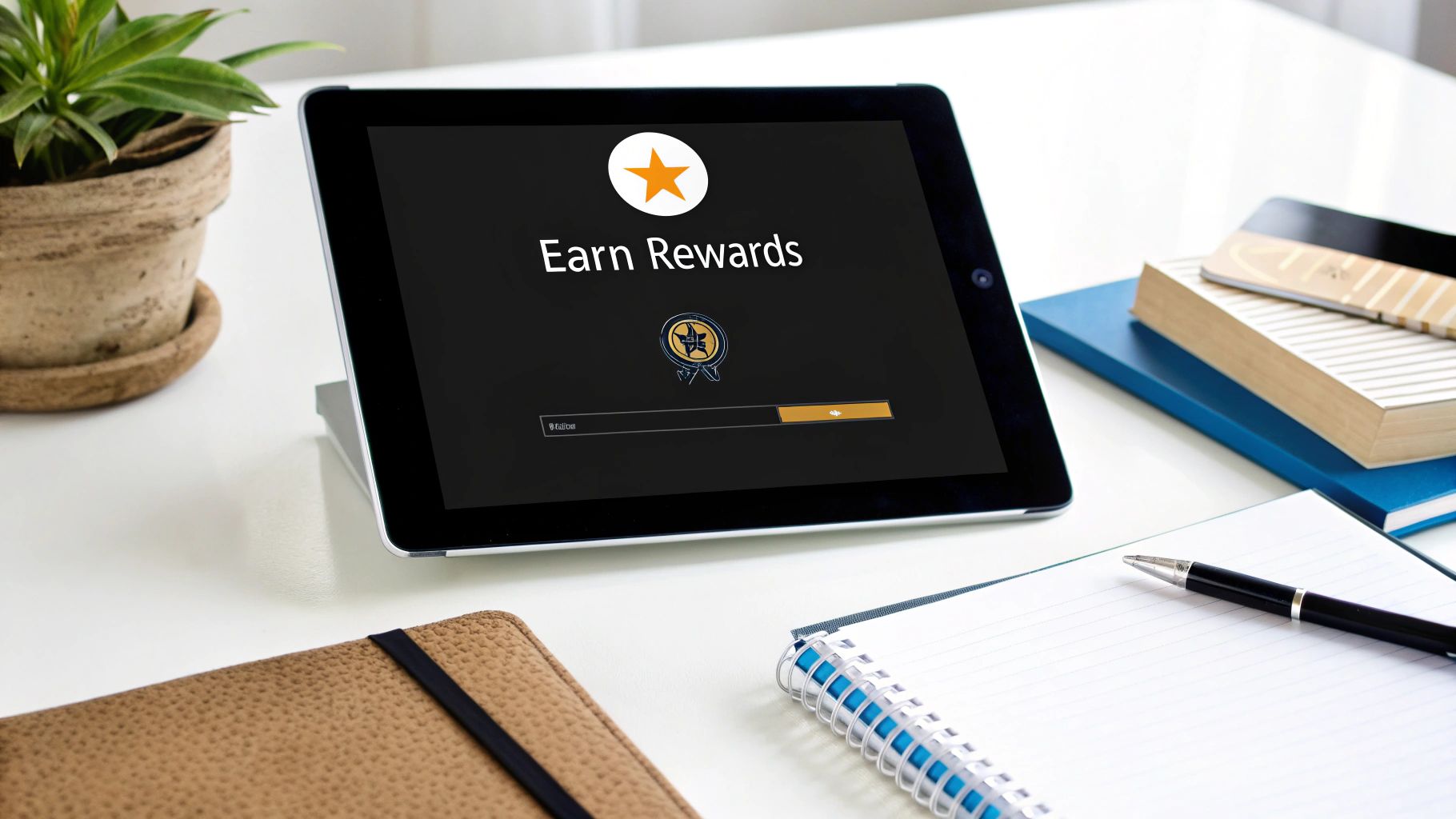
This approach drives retention by creating a compelling feedback loop. When users complete an action and receive a reward, their brain releases dopamine, reinforcing the behavior. This makes them more likely to repeat the action, building a strong habit over time and significantly boosting long-term engagement.
How to Implement Gamification and Reward Systems
Successful gamification is about more than just adding points; it’s about aligning rewards with your app's core value proposition. For example, Duolingo uses streaks, XP points, and leagues to motivate daily language practice, directly supporting its mission. Similarly, Strava fosters a competitive community with segment leaderboards and achievement badges that encourage runners and cyclists to track more activities.
Here are actionable tips to implement this strategy:
- Make Progress Visible: Use progress bars (like LinkedIn's profile completion), levels, or visual trackers to show users how far they've come. Celebrating milestones keeps motivation high.
- Balance Reward Types: Combine predictable rewards (e.g., a badge for logging in 7 days in a row) with variable rewards (e.g., a surprise bonus) to maintain excitement and prevent boredom.
- Create Short-Term Wins: Make early achievements easy to attain. This provides an immediate sense of accomplishment, boosting confidence and encouraging users to stick around for longer-term goals.
- Align Rewards with Core Actions: Ensure points, badges, and other rewards are given for activities that deliver value to the user and align with your business objectives. This reinforces the core purpose of your app.
By thoughtfully integrating these game-like elements, you can create a more addictive and sticky user experience that turns passive users into active, loyal advocates.
4. In-App Messaging and Customer Support
Proactive and contextual communication within your app is a powerful tool for retaining users. In-app messaging and customer support involve delivering targeted messages, tooltips, and easily accessible help channels directly within the app interface. Instead of waiting for users to get stuck or frustrated, this strategy preemptively guides them, announces valuable new features, and resolves issues on the spot. This is one of the most crucial mobile app retention strategies because it makes users feel supported and valued, transforming potential friction points into opportunities for engagement.
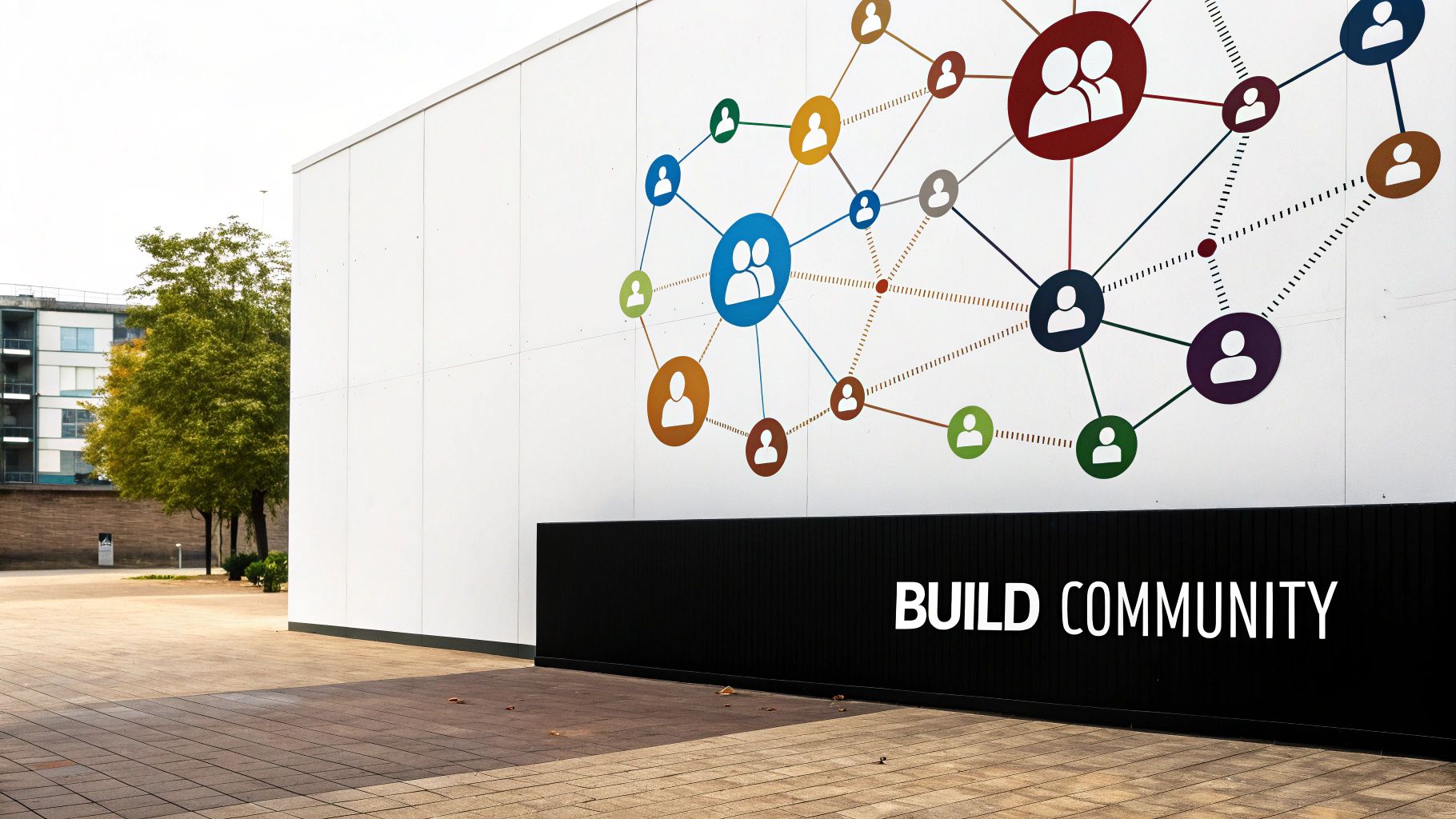
By providing timely assistance, you drastically reduce frustration-based churn. When users can get answers or discover a feature's purpose without leaving the app, they are more likely to overcome obstacles, unlock more value, and continue using your product successfully. This creates a seamless and supportive user journey.
How to Implement In-App Messaging and Customer Support
Effective in-app support is about being present at the right moment with the right information. Grammarly excels at this by providing real-time writing suggestions and explanations directly within the user's workflow, teaching them how to improve as they write. Similarly, Airbnb uses its in-app messaging system not only for host-guest communication but also for providing quick access to platform support, resolving issues without derailing the booking process. These examples show how support can be integrated, not just added on.
Here are actionable tips to implement this strategy:
- Use Behavioral Triggers: Deploy messages based on user actions like time spent on a page, specific clicks, or encountering an error. This ensures your guidance is contextually relevant.
- Segment Your Messages: Tailor communication to different user segments. A new user might need a feature-tour tooltip, while a power user would benefit from an announcement about an advanced update.
- Keep Messages Concise: Ensure your pop-ups and tooltips are short, to the point, and action-oriented. Always provide an easy way for users to dismiss them to avoid causing annoyance.
- Integrate a Help Center: Use a combination of a chatbot for instant answers to common questions and a clear escalation path to a human support agent for more complex problems.
By embedding communication and support directly into the app experience, you build user confidence and prove your commitment to their success, fostering long-term loyalty.
5. Email Re-engagement Campaigns
While much of your focus is on the in-app experience, strategic communication outside the app is crucial for bringing users back. Email re-engagement campaigns are a powerful tool to reconnect with inactive or churning users by reminding them of the app's value, highlighting new features, and offering compelling reasons to return. This is one of the most cost-effective mobile app retention strategies as it targets users who have already shown interest, making them more likely to convert than a cold lead.
These campaigns work by using behavioral data to deliver personalized, timely messages that motivate users to relaunch your app. By addressing specific user segments based on their inactivity, you can deliver relevant content that reminds them why they downloaded your app in the first place, effectively rescuing them before they churn for good.
How to Implement Email Re-engagement Campaigns
Effective re-engagement goes beyond a simple "we miss you" message. It’s about demonstrating tangible value and sparking curiosity. For example, Grammarly sends weekly writing insight emails, summarizing stats like productivity and vocabulary. This data-driven approach encourages users to return to the app to see their progress and improve their writing. Similarly, Spotify's "Here’s what you missed" emails provide inactive users with personalized playlists based on their listening history, showcasing new music they will likely enjoy.
Here are actionable tips to implement this strategy:
- Segment by Inactivity: Group users by how long they’ve been inactive (e.g., 7, 30, 90 days). Tailor the message for each segment, from a gentle nudge for recent drop-offs to a strong incentive for long-dormant users.
- Highlight What's New: Did you launch a killer new feature since they last logged in? Showcase it. This creates a powerful fear of missing out (FOMO) and a compelling reason to check back in.
- Personalize with Data: Use the user's own data to make the email irresistible. A fitness app could say, "You're only 3 workouts away from your monthly goal!" This makes the call to action specific and personal.
- Offer a Strategic Incentive: A discount, free trial extension, or access to premium content can be the push a user needs. Test different offers to see what resonates best with different user segments.
By strategically using email to re-engage lapsed users, you create a safety net that catches users before they’re lost forever, significantly boosting long-term retention.
6. Social Features and Community Building
Integrating social elements transforms solitary app usage into an engaging, shared experience. This strategy builds a community within your app, allowing users to connect, compete, and collaborate. By fostering a sense of belonging and network effects, you create powerful social ties that make the app stickier. This is one of the most powerful mobile app retention strategies because leaving the app means losing valuable social connections, shared history, and community status.
When users build relationships and a reputation within an app, its value extends beyond its core functionality. The community itself becomes a key feature, driving users to return to interact with friends, check leaderboards, or contribute to group discussions, significantly reducing the likelihood of churn.
How to Implement Social Features and Community Building
Effective community building starts with features that feel natural to the app's purpose. For example, Strava has built a massive social network for athletes by allowing them to follow each other, give "Kudos" on activities, and compete on shared segments. This creates a loop of motivation and engagement. Similarly, Peloton uses live leaderboards and virtual "high-fives" to simulate the energy of a group fitness class, making solo workouts feel communal.
Here are actionable tips to implement this strategy:
- Balance Competition with Collaboration: Offer both leaderboards for friendly competition and team-based challenges or forums where users can support one another.
- Make It Easy to Invite Friends: Implement simple sharing and invitation flows so users can easily bring their existing social circles into the app, accelerating network growth.
- Highlight User Achievements Socially: When a user hits a milestone, allow them to share it easily within the app's community or on external social networks. This provides social proof and motivates others.
- Implement Robust Moderation: A healthy community requires safety. Provide clear guidelines and easy-to-use reporting and moderation tools to prevent negative behavior.
By weaving social features into the core app experience, you create a vibrant ecosystem that users invest in. This sense of community and shared purpose is a formidable defense against user attrition.
7. Content Personalization and Recommendation Engines
Beyond a tailored first impression, long-term retention thrives on continuously delivering relevant content. Content personalization uses user data and machine learning algorithms to create an experience that feels uniquely crafted for each individual. Instead of a one-size-fits-all feed, users see products, articles, or media that align with their past behavior and stated interests. This is one of the most powerful mobile app retention strategies because it transforms your app from a generic tool into an indispensable, personal companion.
When every interaction surfaces something valuable and relevant, users have a compelling reason to return day after day. This strategy directly boosts engagement metrics and reinforces the app's value proposition, making it incredibly difficult for a user to churn.
How to Implement Content Personalization
Effective personalization engines learn from both implicit signals (what users do) and explicit signals (what users say). TikTok's "For You Page" is a masterclass in this, rapidly learning from micro-interactions like watch time and shares to curate an addictive, hyper-personal feed. Similarly, Netflix attributes over 80% of its content viewership to its sophisticated recommendation engine, which keeps users engaged and subscribed.
Here are actionable tips to implement this strategy:
- Combine Multiple Data Points: Use a mix of user data for your engine, such as purchase history, browsing behavior, location, and time of day, to create more accurate recommendations.
- Balance Relevance and Discovery: While personalizing, strategically inject new or diverse content to prevent "filter bubbles" and help users discover new interests within your app.
- Address the "Cold Start" Problem: For new users with no history, use popular items or ask for a few initial preferences to get the personalization engine started immediately.
- Allow User Feedback: Include features like "show me less of this" or "I'm not interested" to give users control and provide explicit data to fine-tune your algorithm.
By building a smart recommendation engine, you ensure the app experience evolves with the user, consistently delivering fresh, relevant content that keeps them coming back for more.
8. Value-Based Lifecycle Marketing
A user's needs on day one are vastly different from their needs on day one hundred. Value-based lifecycle marketing is a holistic strategy that recognizes this evolution, delivering tailored messages and experiences based on where users are in their journey. This approach segments users into stages like new, active, at-risk, and dormant, ensuring every interaction is relevant and timely. This is one of the most sophisticated mobile app retention strategies as it moves beyond one-size-fits-all communication to nurture users at scale.
This method proactively guides users toward becoming power users by providing stage-appropriate value. For new users, the focus is activation; for active users, it's habit formation; and for at-risk users, it's re-engagement. This prevents churn by addressing specific needs and friction points before they become critical issues.
How to Implement Value-Based Lifecycle Marketing
Effective lifecycle marketing starts with defining clear stages based on user behavior and engagement metrics. For example, Dropbox excels at this by tying its lifecycle marketing to storage usage. A user approaching their limit receives different messages and upgrade prompts than a brand-new user who has just uploaded their first file. Similarly, Canva provides progressive feature education, introducing advanced tools only after a user demonstrates mastery of basic functions.
Here are actionable tips to implement this strategy:
- Define Lifecycle Stages: Map out key stages in your user journey (e.g., New User, Activated, Engaged, Power User, At-Risk, Churned) based on app-specific behaviors and timelines.
- Identify Key Transition Behaviors: Determine the actions that signal a user is moving from one stage to the next. This could be completing 5 core actions, inviting a friend, or a period of inactivity.
- Create Stage-Specific Campaigns: Develop unique messaging, in-app guides, and push notification campaigns for each stage. A new user might get a "getting started" guide, while an at-risk user receives a "we miss you" offer.
- Automate Where Possible: Use marketing automation tools to trigger campaigns when users enter a new stage. This ensures timely and consistent communication without constant manual oversight.
By aligning your marketing with the user lifecycle, you create a dynamic and supportive app environment that adapts to user needs, significantly boosting long-term loyalty and retention.
9. Progressive Feature Unlocking and Paywalls
Strategically gating features, content, or functionality guides users through increasing levels of value while creating natural upgrade paths. Instead of immediately hitting users with a hard paywall, this approach provides a valuable free experience that organically showcases the benefits of a premium offering. This is a powerful component of modern mobile app retention strategies because it proves the app's core value first, turning free users into paying customers who are more invested in the product's ecosystem.
This method balances generous free access with compelling reasons to upgrade. By allowing users to experience the app's benefits before committing financially, you build trust and demonstrate potential, making the eventual upgrade decision feel like a natural next step rather than a forced transaction. This builds a sustainable revenue model that funds ongoing development and user retention efforts.
How to Implement Progressive Unlocking and Paywalls
Effective implementation hinges on providing a genuinely useful free tier that solves a real problem for the user. The goal is to make the free version so good that users can't imagine how much better the paid version must be. For instance, Grammarly offers excellent free grammar and spelling checks, but gates advanced suggestions like tone adjustments and clarity improvements behind its premium paywall. Similarly, Spotify allows unlimited ad-supported streaming for free but reserves ad-free listening and offline downloads for paying subscribers.
Here are actionable tips to implement this strategy:
- Offer Genuine Free Value: The free tier must be useful on its own. If it feels like a crippled demo, users will churn without ever considering an upgrade.
- Gate Features Based on User Maturity: Lock features that solve "power user" problems. A new user may not need advanced analytics, but an engaged user who has used the app for weeks will see its value.
- Use Soft Paywalls and Previews: Instead of just a "Upgrade Now" button, show a disabled premium feature with a tooltip explaining its benefits. This contextual prompting is far more effective than a generic pop-up.
- Highlight Benefits at Moments of Need: Trigger an upgrade prompt when a user attempts an action that a premium feature solves. LinkedIn does this perfectly when a user exhausts their free profile views or InMail credits.
By progressively revealing value, you create an experience where users upgrade because they want to, not because they are forced to. This builds a healthier, more sustainable relationship with your user base and is a key driver of long-term retention and revenue.
10. Performance Optimization and Technical Excellence
Technical glitches, slow load times, and frequent crashes are among the quickest ways to lose a user for good. Performance optimization is the continuous effort to ensure your app is fast, stable, and reliable. This foundational strategy focuses on the core user experience, recognizing that even the most innovative features are useless if the app doesn't work smoothly. This is one of the most crucial mobile app retention strategies because it builds trust and removes friction, making your app a pleasure to use.
A technically excellent app feels professional and dependable. Users subconsciously associate speed and stability with quality, making them more likely to return. Conversely, an app that drains battery or lags during navigation creates frustration and quickly leads to uninstalls.
How to Implement Performance Optimization
Achieving technical excellence requires a proactive, data-driven approach. It isn't a one-time fix but a commitment to continuous monitoring and improvement. For example, Google Maps ensures reliability by offering offline functionality, allowing users to navigate even without a connection. Similarly, Instagram heavily optimizes image loading, so content appears quickly even on slower networks, ensuring a smooth scrolling experience.
Here are actionable tips to implement this strategy:
- Prioritize App Launch Speed: A user's perception of performance is formed within seconds. Aim for a launch time under two seconds to make a strong first impression.
- Implement Robust Crash Reporting: Use tools to immediately detect, diagnose, and fix crashes. Prioritize fixing the most frequent crashes affecting the largest number of users.
- Optimize for All Conditions: Test your app on older devices and simulate poor network conditions. Implement features like lazy loading and offline modes so the app remains functional.
- Reduce App Size and Resource Usage: A smaller app is quicker to download and install. Continuously monitor and optimize battery and data consumption, especially for background processes.
By embedding technical excellence into your development cycle, you create a seamless and frustration-free experience. This solidifies user trust and provides the stable foundation necessary for all other retention efforts to succeed.
Mobile App Retention Strategies Comparison
| Strategy | Implementation Complexity 🔄 | Resource Requirements ⚡ | Expected Outcomes 📊 | Ideal Use Cases 💡 | Key Advantages ⭐ |
|---|---|---|---|---|---|
| Personalized Onboarding | High 🔄🔄🔄 | High ⚡⚡ | Faster time-to-value, higher feature adoption, reduced churn | New user activation, feature discovery | Reduces abandonment, creates strong first impression |
| Push Notification Optimization | Medium 🔄🔄 | Medium ⚡⚡ | Increased re-engagement, improved retention, measurable impact | User re-engagement, reminders, promotions | Direct channel, cost-effective, drives timely engagement |
| Gamification and Reward Systems | High 🔄🔄🔄 | High ⚡⚡ | Boosted engagement, habit formation, reduced churn | Engagement, habit building, motivation | Increases session time, promotes exploration, social proof |
| In-App Messaging & Support | Medium 🔄🔄 | Medium ⚡⚡ | Improved user guidance, reduced frustration, support insights | User assistance, onboarding, feature announcements | Contextual help, reduces support load, increases satisfaction |
| Email Re-engagement Campaigns | Medium 🔄🔄 | Low-Medium ⚡ | Recover dormant users, measurable engagement | Re-engagement of inactive users | Cost-effective, detailed messaging, works outside app |
| Social Features & Community | High 🔄🔄🔄 | High ⚡⚡ | Strong network effects, increased engagement, viral growth | Community building, social engagement | Builds emotional connection, drives organic growth |
| Content Personalization Engines | High 🔄🔄🔄 | High ⚡⚡ | Increased content discovery, higher satisfaction, retention | Customizing user experience, content-heavy apps | Unique experiences, improves with data, reduces fatigue |
| Value-Based Lifecycle Marketing | High 🔄🔄🔄 | High ⚡⚡ | Targeted messaging, improved retention, proactive churn management | Lifecycle stage engagement, retention strategies | Data-driven, maximizes efficiency, predictive insights |
| Progressive Feature Unlocking | Medium-High 🔄🔄🔄 | Medium ⚡⚡ | Clear upgrade paths, increased revenue, motivated engagement | Freemium apps, monetization-focused | Balances free/paid value, creates upgrade incentives |
| Performance Optimization | High 🔄🔄🔄 | High ⚡⚡⚡ | Faster load times, fewer crashes, higher satisfaction | All apps, foundational for all retention efforts | Reduces frustration churn, improves app reputation |
Turning Retention Strategies into Sustainable Growth
Navigating the competitive landscape of the app stores requires more than just a brilliant acquisition strategy; it demands an unwavering commitment to user retention. The journey from a first-time user to a loyal advocate is not accidental. It is meticulously designed, built upon a foundation of delivering consistent, evolving value. Throughout this guide, we've explored ten powerful mobile app retention strategies, each serving as a crucial component in building an engaging and enduring user experience.
From the very first interaction shaped by personalized onboarding to the ongoing dialogue facilitated by optimized push notifications and in-app messaging, the goal is to make every user feel seen, understood, and valued. We've seen how integrating gamification and social features can transform passive consumption into active participation, fostering a sense of community and achievement that keeps users coming back. This isn't just about features; it’s about creating an ecosystem.
The true art of retention lies in weaving these individual tactics into a cohesive and intelligent system that adapts to the user's lifecycle, a concept we covered in value-based lifecycle marketing. This holistic approach ensures that your efforts are not just isolated campaigns but a continuous, reinforcing cycle of engagement.
From Theory to Action: Your Implementation Roadmap
Mastering mobile app retention is an iterative process, not a one-time project. It’s about building a culture of continuous improvement fueled by data and user feedback. Avoid the temptation to implement all ten strategies at once. Instead, adopt a focused, methodical approach to turn these insights into tangible results.
1. Diagnose Your Leaks: Begin by diving into your analytics. Pinpoint exactly where users are dropping off. Is it after the first session? Following a specific in-app event? Before they discover a key feature? Identifying these friction points is the most critical first step, as it tells you where to focus your resources for the greatest impact. For instance, high churn after day one points to a weak onboarding experience, while a drop-off before a purchase suggests a problem with your value proposition or paywall.
2. Prioritize and Execute: Based on your diagnosis, select one or two strategies that directly address your most significant churn points.
- Early Churn Problem? Focus on Personalized Onboarding (#1) and Progressive Feature Unlocking (#9) to demonstrate immediate value.
- Low Long-Term Engagement? Prioritize Gamification (#3) and Community Building (#6) to create lasting investment.
- Poor Conversion Rates? Refine your Value-Based Lifecycle Marketing (#8) and optimize the performance of your paywalls.
3. Measure, Iterate, and Scale: Once you've implemented a strategy, establish clear Key Performance Indicators (KPIs) to measure its success. Track metrics like Day 1, Day 7, and Day 30 retention, session length, feature adoption rates, and conversion rates. Use A/B testing to refine your approach, whether it's tweaking push notification copy, experimenting with reward systems, or optimizing your app’s performance. As you validate the success of one initiative, you can strategically layer on the next, building a robust, multi-faceted retention engine.
Ultimately, the most effective mobile app retention strategies are those that put the user experience at the core of every decision. By focusing on technical excellence, delivering personalized value, and fostering a genuine connection, you don't just reduce churn; you build a thriving digital ecosystem. This commitment transforms your app from a disposable tool into an indispensable part of your users' daily lives, securing sustainable growth and long-term success.
Monetization and retention are deeply intertwined, and a poorly designed paywall can be one of the biggest friction points in your user journey. With Nuxie, you can rapidly A/B test AI-generated, conversion-optimized paywalls for your iOS app without writing a single line of code. Stop guessing what works and start implementing high-performing paywalls that support your retention efforts by visiting Nuxie.
Article created using Outrank